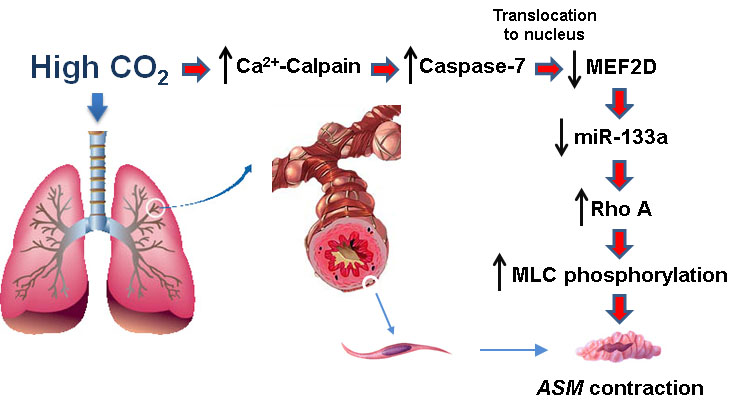Presenting Author:
Principal Investigator:
Jacob Sznajder, M.D.
Department:
Medicine
Keywords:
Hypercapnia, airway contraction, caspase-7
Location:
Third Floor, Feinberg Pavilion, Northwestern Memorial Hospital
B80 - Basic Science
Non-canonical role of caspase-7 in airway contraction during hypercapnia
RATIONALE: There is increasing evidence that hypercapnia is associated with poor prognosis in patients with lung diseases such as COPD and obesity hypoventilation syndrome. However, there is lack of evidence on the role of hypercapnia in airway pathophysiology. The present study was designed to explore the mechanisms by which hypercapnia affects airway smooth muscle (ASM) contraction. METHODS: ASM cells were isolated from mouse trachea in control (room air) conditions and cultured in normoxic/normocapnic and normoxic/hypercapnic conditions. The buffering capacity of the culture medium was modified to obtain a pH of 7.4 at the various CO2 levels. Acetylcholine-induced cell contraction was examined by time-lapse microscopy. RhoA, MEF2D, and cleaved caspase-7 were analyzed by Western blotting. Micro RNA-133a (miR-133a) was examined by qPCR. Calpain activity was determined using a calpain activity assay kit. Intracellular Ca2+ in cells was measured by the Fura-2 system. For in vivo experiments, adult male C57BL/6 mice were maintained for 21 days in room air or normoxic-hypercapnia (21% O2 and 10% CO2) conditions and then some mice were returned for 14 days to control conditions. The lungs were excised and analyzed the acetylcholine-induced airway response was assessed in precision cut lung slices by time-lapse microscopy. RESULTS: In cultured ASM cells, we determined that normoxic-hypercapnia promotes acetylcholine-induced ASM cell contraction through the following chain of events: Normoxic-hypercapnia increases intracellular Ca2+, thereby activating calpain that cleaves caspase-7, which through a non-canonical activity degrades the transcription factor MEF2D. Since MEF2D activates expression of miR-133a, normoxic-hypercapnia reduced miR-133a abundance, thereby increasing RhoA abundance and consequent acetylcholine-induced cell contraction. In vivo experiments confirmed that normoxic-hypercapnia increases airway reactivity to acetylcholine, and this resolved after return of mice to control conditions after hypercapnia. CONCLUSIONS: These data suggest that hypercapnia elicits a non-canonical role for caspase-7 leading to ASM contraction. These findings are of potential clinical relevance to hypercapnic patients with obstructive lung diseases and support the recently reported strategy aimed at reduction of PaCO2 as beneficial for patients with COPD.

